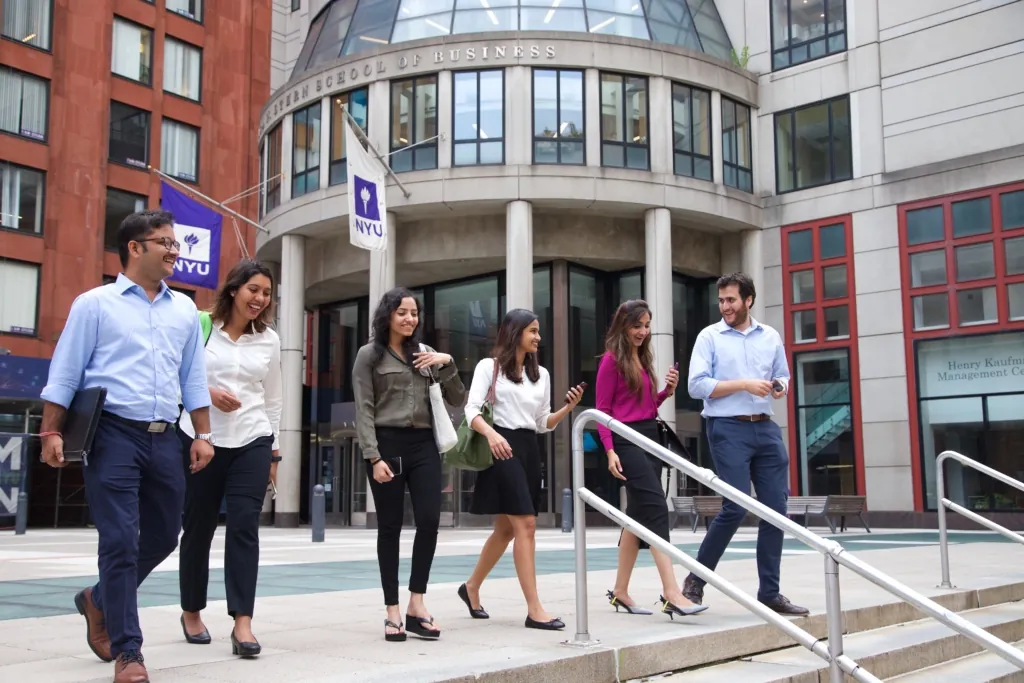NYUMBA students outside the Stern School of Business in New York City
The MBA holds the most popular graduate degree in the United States since 2010-2011, beyond the Master of Education degree as the first choice for graduate students. According to AACSB, just over 250,000 students worldwide are enrolled in the MBA program.
But how many of them are in the top program?
Not so many. The prestigious business school with the highest number of MBA students is now the Wharton School of the University of Pennsylvania, with a total enrollment of 1,874, less than 1% (0.7%) of all MBA students in the United States. 2 Harvard Business School, 1,742 MBA students enrolled. The MBA will be earned in two years, so of course these numbers will be divided into graduation class sizes.
Less than 4% (3.8%) of MBAs have a degree in so-called M7 Business School (Stanford, Harvard, Wharton, Colombia, Kellogg, Booth, or Sloan). Over 1,000 students are enrolled in just five prestige programs (Wharton, Harvard, Colombia, Kellogg, Booth).
Only 4.6% of students studying for an MBA attend the top 10 business schools (list to add Yale, Berkeley Haas, and Dirtmas Stack). And only 8.6% are enrolled in the full-time MBA program of the top 25 business schools, with the smallest being the University of Washington’s Foster Business School, which enrolls 235 students.
Wharton’s MBA enrollment is higher than the combined enrollment of 15 of the top 50 MBA programs with the fewest student associations.
10 Largest Prestige MBA Programs in the U.S.
| school | Total number of registrations | P & Q rank | Lifetime earnings of graduates |
|---|---|---|---|
| Pennsylvania (Wharton) | 1,874 | 3 | $ 7,440,000 |
| Harvard Business School | 1,742 | Five | $ 8,500,000 |
| Northwest (Kellogg) | 1,425 | Four | $ 7,860,000 |
| Columbia Business School | 1,426 | 7 | $ 6,800,000 |
| Chicago (booth) | 1,249 | 2 | $ 6,740,000 |
| MIT (Sloan) | 934 | 6 | $ 7,890,000 |
| Stanford GSB | 897 | 1 | $ 8,330,000 |
| Duke (Fukua) | 855 | 11 11 | $ 7,330,000 |
| Michigan (Loss) | 747 | 12 | $ 6,860,000 |
| Virginia (Darden) | 746 | 14 | $ 8,200,000 |
Note: Registration count includes students enrolling in the fall of 2021.
Cohorts, clusters and sections split MBA in large schools
Of course, large schools divide the enrolled students into sections or clusters to provide a more intimate MBA experience for the students. At Wharton, enrolled students are initially placed in four clusters of about 216 students, then into 12 cohorts of about 72 students, and finally 144 consisting of 5-6 MBA candidates. You can join the learning team of.
Jess Seagull, director of the Strategic Initiative for Wharton’s McNulty Leadership Program, said: “The cluster and cohort system needed more than 860 groups and was designed with the expectation that it would feel like a smaller community.”
At Harvard, this is a somewhat similar system in which first-year MBA students are assigned to specific “sections.” Each of the 10 groups consists of about 90 students. In the first year, all 10 classes in the required curriculum will be taken together. Conclusion: Your sectionmate will probably be your closest friend at business school. This is true even if the section is split during the second year elective curriculum where students choose from over 100 electives or re-register with another Harvard University, MIT Faculty of Business Administration, or Tufts Fletcher Diplomatic School. This is true.
A small pair. Large MBA School: What’s the Difference?
In any case, the size of the program can make a meaningful difference in both the school culture and the student experience. Small school students of 350 or less tend to interact with most peers and professors at some point in a typical two-year MBA program. As a result, small schools are generally considered “knowledgeable” and their communities tend to be very closely linked. Treasury clubs can have only one president in both small and large schools, so it’s easy to get a leadership position in a small environment, but competition for such a position is a big program. Then it will obviously be bigger.
On the other hand, school students with more than 1,000 students may not be able to know each of their classmates by the end of the program, and some prefer this. After all, some individuals may prefer to be in a larger school where they can better maintain their anonymity if they choose to do so. Large class advocates tout the benefits of being able to interact with more people and develop a wider and more robust network of peers during the MBA experience.
10 smallest prestige MBA programs in the United States
| school | Total number of registrations | P & Q rank | Lifetime earnings of graduates |
|---|---|---|---|
| Georgia Tech (Sheller) | 145 | 27 | NA |
| University of Washington (Foster) | 235 | twenty one | $ 6,600,000 |
| Indiana (Kelly) | 246 | twenty two | $ 5,530,000 |
| Emory (Goizueta) | 301 | 26 | NA |
| Notre Dame (Mendoza) | 316 | 31 | NA |
| Rice (Jones) | 352 | twenty four | NA |
| Vanderbilt (Owen) | 364 | twenty five | $ 6,030,000 |
| Carnegie Mellon (Tepper) | 371 | 16 16 | $ 6,750,000 |
| Southern California (Marshall) | 439 | 18 18 | $ 5,130,000 |
| Texas-Austin (McCommes) | 487 | 20 | $ 6,350,000 |
Note: Registration count includes students enrolling in the fall of 2021
(See next page for the 50 largest Prestige MBA programs in the United States)


Commentaires
Enregistrer un commentaire